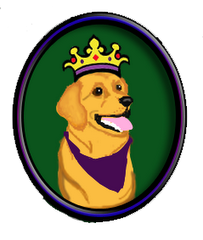Don't Eat The Daisies!
Many of the plants in our homes and gardens can make your pet quite sick if ingested, and many can even be fatal. If your dogs are like mine, they like to “graze”. They nibble on grass and leaves all the time. It doesn’t make them sick, they just seem to like to eat it. My youngest beagle, who chews on everything, will take the leaves off anything that looks appealing to him at the time. While most of the time it’s just an annoying habit, in many cases it could be dangerous or life-threatening.
It is important to know the plants in your home and garden, and any possible dangers they may pose for your pets or your children. You don’t have to get rid of the plant(s), just make sure your pets can’t get to them.
There are hundreds of plants that range from mildly toxic to quite deadly. Symptoms can range from mild gastrointestinal irritation to sudden death. Some toxins will have only a temporary effect, while others can cause permanent damage.
I will list some of the most common toxic plants your pet may come in contact with, with special note of the most deadly ones. This list is in no way comprehensive. All information is from the ASPCA Poison Control site, and the Humane Society of the United States site. I will include links at the end so you may get the complete and detailed lists they have posted.
Let’s start with some of the most toxic:
Nightshade (belladonna): All parts of the plant are considered extremely poisonous, with the roots being the most toxic. This plant contains atropine, which acts to block nerve transmissions between the brain and vital organs such as the heart and lungs. Symptoms include dilated pupils, irregular heartbeat, aggression, stupor, loss of vision, paralysis, sever shaking of rear legs, weak pulse, bloat, stumbling, rapid breathing, paling of skin followed by a red rash, intense urges to swallow, severe intestinal disturbances, skin may dry and peel off, coma, or death. Fatal levels of this toxin can be ingested from as little as a few berries to a single leaf. This is a fairly common weed which I have found growing in my own yard.
Yew (taxus): Yews are an ornamental shrub that are common in many home landscapes. All parts of the plant are poisonous. It can affect the nervous system, causing weakness, trembling and breathing difficulties. It can also cause gastrointestinal upset, cardiac failure, and even sudden death. Even very small amounts can be fatal.
Poison Hemlock: This is not the evergreen hemlock tree. This one is a tall perennial plant. All parts of this plant are toxic. Symptoms of poisoning include dilated pupils, frothing at the mouth, muscle spasms, restlessness, convulsions, and sudden death.
Azalea: All parts are toxic, leaves in particular. Symptoms include drooling, diarrhea, vomiting, weakness, depression, abnormal heart rate and rhythm, convulsions, coma, or death.
English Ivy: Leaves and berries are toxic. Symptoms include gastrointestinal irritation, diarrhea, breathing difficulties, coma, or death.
Castor Bean: All parts are toxic, seeds in particular. The toxin in this plant is ricin, an extremely toxic substance that has been used in chemical warfare. Symptoms of poisoning include abdominal pain, drooling, diarrhea, vomiting, excessive thirst, weakness, tremors, dehydration, seizures, muscle twitching, coma, or death. Only a tiny amount can be fatal, with death occurring within 36 hours of ingestion.
JimsonWeed All parts are toxic. Symptoms include rapid pulse, rapid breathing, dilated pupils, restlessness, nervousness, twitching, frequent urination, diarrhea, depression, weight loss, weak pulse, convulsions, coma, or death.
Sago Palm: All parts are toxic, seeds in particular. Symptoms include diarrhea, vomiting, depression, seizures, and liver failure.
Johnson Grass: Leaves and stems are toxic, particularly in young plants. Symptoms include breathing problems, severe anxiety, convulsions, coma, or death. There is an intravenous antidote for this one if caught in time.
Lantana: Leaves and berries are toxic. Symptoms include sluggishness, weakness, bloody diarrhea, and in severe cases, death may occur in 2 to 4 days.
Foxglove (digitalis): All parts of this plant are toxic. The chemical toxin is digitoxin, which is used to make the heart medicine Digitalis. Ingestion of this plant will initially cause nausea and vomiting. Serious symptoms include diarrhea, anorexia, low pulse rate, visual disturbances, confusion, cardiac arrhythmias (irregular heartbeat), cardiac arrest, and death. This toxin mostly affects the heart, causing it to become overburdened and eventually stop.
Cyclamen: All parts are toxic, roots in particular. Symptoms include severe vomiting, gastrointestinal inflammation, or death.
Kalanchoe: All parts are toxic. The toxin in this plant affects the central nervous system and the heart. Symptoms include vomiting, diarrhea, increased heart rate, or irregular heartbeat.
Lilies: Plants of the lilium variety are highly toxic to cats in particular. Ingesting even very small amounts can cause serious kidney damage.Tulips / narcissus: The bulbs are toxic. Symptoms include drooling, gastrointestinal irritation, loss of appetite, depression of the central nervous system, convulsions, and cardiac abnormalities.
Oleander: All parts of this plant toxic, primarily affecting the heart. Symptoms include gastrointestinal irritation, hypothermia, abnormal heart function, or death.
Autumn Crocus (colchicum): Symptoms of ingestion include oral irritation, bloody vomiting, diarrhea, shock, multi-organ damage, and bone marrow suppression.
Glory Lily (gloriosa): This plant contains the toxin colchicine, which is comparable to arsenic in its effects. Initial symptoms include irritation of the mouth and throat, vomiting with or without blood, diarrhea, and abdominal pain. These symptoms occur within the first 2 to 5 hours. During the next 24 to 72 hours, life threatening symptoms may occur. These symptoms include irregular heartbeat, heart failure, respiratory distress, suppression of bone marrow, kidney failure, and muscle weakness. These symptoms may last from 3 to 7 days, with death resulting from respiratory failure.
These are some of the more toxic plants you may find in your home, garden or yard.
A few other plants that are toxic to varying degrees include:
Amaryllis, Bird of Paradise, Philodendron, Mistletoe, Poinsettia, Jerusalem Cherry, Iris, Lily of the Valley, Bittersweet, Clematis, Pothos, Gladiolas, Hydrangea, Mandrake, Morning Glory, Pokeweed, Amaranthus, Rhubarb, Daffodils, and Dieffenbachia.
This is by no means a complete list. For a more comprehensive list of toxic plants, symptoms, and treatments, check out some of the following links:
ASPCA: Toxic and Non-Toxic PlantsHSUS: Plants Potentially Poisonous to Pets
Read More......
















































